by H. C. Robbins Landon
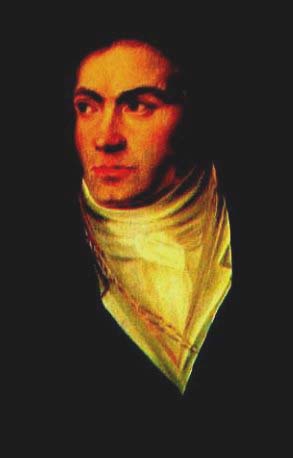
-------- Beethoven. Portrait in oils by Isidor Neugass. 1806. Mme.
Françoise de Cassette. Paris.
This portrait, of which Neugass made another copy for Prince Lichnowsky, was commissioned by Count Brunsvik. For many years the portrait was lost and was only recently rediscovered in Paris. This is its first reproduction in color. It shows the elegant Beethoven who moved freely in aristocratic Viennese society and was even something of a dandy. Beethoven wore a lorgnette at this period in his life and the painter has included the string to which the lorgnette was attached.
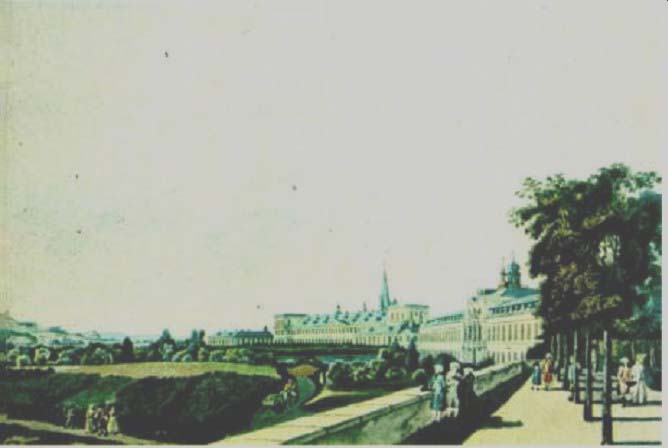
-------- The castle at Bonn. Colored engraving by Johann Zeigler,
from a drawing by Laurenz Janscha, dated 1798. Städtische Sammlungen,
Bonn.
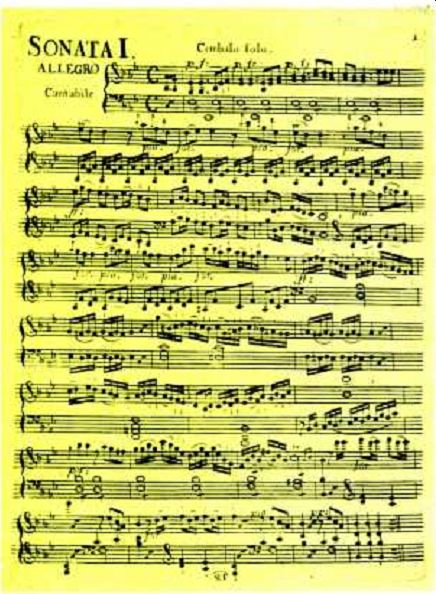
------------- Three Sonatas for Piano (Kinsky. WoO 47, first edition)
by Beethoven, published in 1783 by Bossier in Speyr and dedicated to
the Elector Maximilian Friedrich.
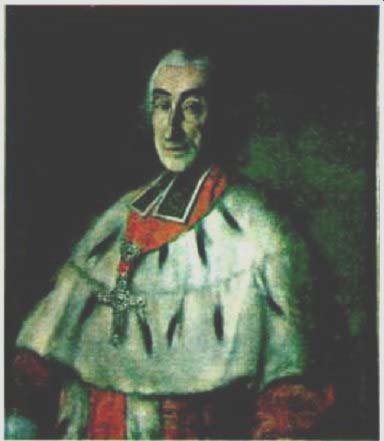
------------- The Elector and Archbishop of Cologne.
Maximilian Friedrich, Count von Königsegg-Aulendorf. Anonymous portrait in oils; Städtische Sammlungen, Bonn.
Bonn was a quiet, provincial town, prettily situated on the Rhine; Beethoven was born there on December 15, 1770, and received his earliest musical education from his father, who was a tenor. Beethoven's great musicality showed at an early age, and his father thought to make a Wunderkind out of Ludwig, using Mozart as his model. Beethoven later studied with Christian Gottlob Neefe and became a viola player in the court orchestra. He also became the court organist.
The Elector of Cologne, Maximilian Friedrich, Count von Königsegg-Aulendorf, who was also Archbishop of Cologne, resided in Bonn. An efficient and respected ruler, he brought an international glitter Jo the otherwise provincial atmosphere. The Elector died in 1784 and the Hapsburg brother of Emperor Joseph II became the new ruler of Bonn.
The year before Elector Maximilian Friedrich's death, Beethoven's three earliest sonatas were published and dedicated to him. These sonatas were well received by musical connoisseurs and did much to establish Beethoven's name in Germany. He was thirteen when they were published.

------------ Prince Innocenz d'Erba Odescalchi and Princess Babette
nee Countess von Keglevich de Buzin. Anonymous portraits in oils: Prince
Odescalchi, Rome.

------------- Silhouettes of Haydn and Mozart by Hieronymus Löschenkohl.
H. C. Robbins Landon, Buggiano Castello.
Friends in Bonn sent Beethoven to Vienna in 1787 to study with Mozart; the younger composer had had only a few lessons before the news reached him that his mother was dying; he returned to Bonn and had to support the family after his mother's death, for his father was by now a drunkard and Ludwig had two younger brothers to care for. In 1790 Haydn passed through Bonn on his way to London, and either at this time or on his return journey met Beethoven, who gave Haydn his latest work, the Cantata on the death of the Emperor Joseph II. Haydn was impressed by the young man and agreed to take him on as a pupil. Beethoven left Bonn in 1792 to study with Haydn in Vienna and never again returned to his native city. Haydn was not a conscientious teacher but Beethoven learned from him many of the tricks of the trade; relations between the two men were never very cordial, but Haydn immediately realized the young man's genius and wrote in 1793, "the time will come when Beethoven will be Europe's leading composer and I shall be proud to have been known as his teacher." Beethoven soon made many friends among Vienna's aristocracy, and the list of subscribers in his Op. 1 (three piano trios), published in 1794, reads like an extract from the Almanach de Gotha.
Beethoven's patrons included people like Haydn's Princess Marie Hermenegild Esterházy, Prince Carl Lichnowsky (a pupil of Mozart), Baron van Swieten (author of the textbooks to The Creation and The Seasons, to whom Beethoven dedicated his First Symphony), and the Odescalchis, members of a rich and ancient Roman patrician family. Princess Babette took piano lessons from Beethoven and among the various pieces that the composer dedicated to her, the Piano Concerto in C, Op. 15 is outstanding.
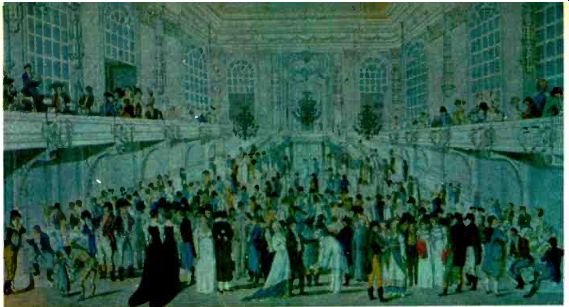
------------ Masked ball in Vienna's Redoutensaal. Colored engraving
by Joseph Schütz, c. 1800. Professor Hans Swarowsky, Vienna.

--------------- Josephine Countess von Deym, nee Brunsvik. Anonymous
miniature portrait; Beethovenhaus, Bonn.
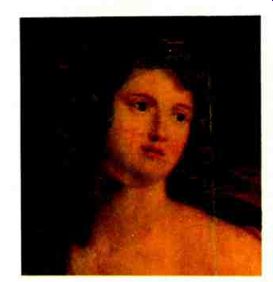
------------- Countess Giulietta Guicciardi, later Countess von
Gallenberg. Anonymous portrait in oils on wood. Formerly from the Brunsvik
castle at Korompa, CSSR.
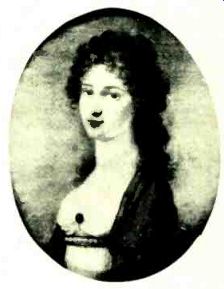
--------------- Countess Marie Erdödy, nee Niczky. Anonymous miniature
on ivory from Beethoven's possession, now in the Beethovenhaus, Bonn.
Vienna became Beethoven's second home; apart from occasional concert journeys before he lost his hearing and a number of summer trips, he spent the rest of his life in the Austrian capital. When he arrived in Vienna, the city was already enjoying an enormous reputation as a musical center: Haydn and Mozart had made it famous throughout musical Europe.
Beethoven's first major orchestral work in Vienna was a set of dances for the famous Redoutensaal balls, for which Haydn and Mozart had composed some of their most beautiful dance music. Beethoven composed for the season of 1795 Twelve German Dances and Twelve Minuets for full orchestra, which were great successes and did much to spread his popularity from Germany to Austria.
Beethoven fell in love many times in his life, and being something of a snob, most of his girl friends were members of the aristocracy. One such love affair was with Josephine Countess von Deym; Beethoven was very fond of the whole Brunsvik family, and to Josephine's brother Franz he dedicated the Appassionata Sonata. He was also an intimate friendof Countess Therese Brunsvik. Beethoven wanted very much to marry Josephine, who was at that time a widow; she was attracted to Beethoven but considered, quite rightly, that he would not have the economic means to support her and her young children. Beethoven was heartbroken at her refusal.
Giulietta was a cousin of the Brunsvik family and studied piano with Beethoven, who then proceeded to fall passionately in love with her. He dedicated to her the famous Moonlight Sonata, Op. 27, No. 2, in 1801. Her mother thought the match unsuitable and Giulietta was married off to Count Gallenberg, a profligate and degenerate aristocrat who composed second-rate ballets. There is a note in one of Beethoven's conversation booklets, wherein the composer notes: "She [Countess Guicciardil loved me much more than she loved her husband...." Countess Erdödy, separated from her husband, was herself an excellent pianist and a dear friend of Beethoven; at one point they even shared lodgings.
It is not known whether their relations were intimate, but Beethoven biographers have suspected that they may have had a love affair. Countess Marie helped Beethoven to get over his violent love affair with Countess Guicciardi.
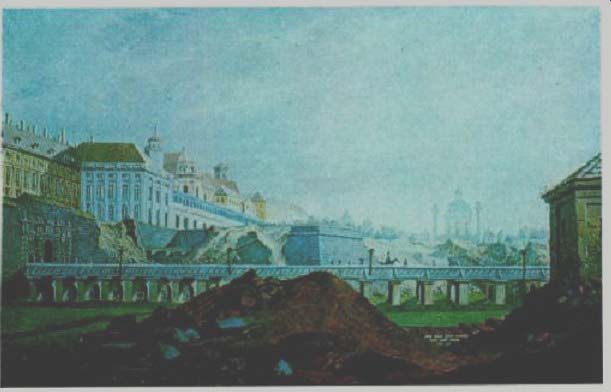
--------------- The city walls of Vienna damaged by French artillery
in 1809. Aquarelle by Franz Jaschke; Historisches Museum of the City
of Vienna.
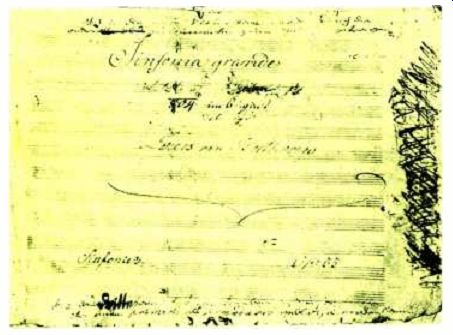
--------------- The original title page of the Third Symphony before
it became the "Eroica ": "N.B. I. Cues for the other instruments
are to be written into the first violin part-Sinfonia grande." Underneath
this, two words are obliterated; one, partially torn, is "Bonaparte." "804
im August [this refers to the year 18041-de Sigr Louis van Beethoven." Under
this, one can still make out Beethoven's erased penciled script, "Composed
on Bonaparte." "Sinfonie 3 Op. 55N.B. 2. The third horn is
so written that it can be played by by [sic[ a primario as well as a
secundario." This entire score was purchased in 1827 by the Viennese
composer Joseph Dessauer for 3 florins, 10 kreutzers-less than a dollar.
Gesellschaft der Musikfreunde, Vienna.
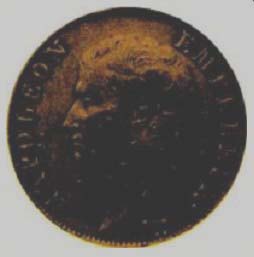
-------------- Gold 40-franc coin struck in Paris, 1805, a year after
Napoleon crowned himself Emperor. The "T" below bust stands
for the engraver, Tiolier. American Numismatic Society, New York City.
French troops twice occupied Vienna, once in 1805 (when Beethoven was producing his opera, Fidelio) and again in 1809. Haydn died on May 31, 1809, and Beethoven was composing his Emperor Concerto as Napoleon's artillery was razing the city's fortifications. At one time Beethoven had been a fervent admirer of Napoleon and had written the Eroica Symphony in his honor. When he heard that Napoleon had crowned himself Emperor in 1804, he tore the original title page and gave the Symphony its new name, Sinfonia eroica; later he said about Napoleon, "I made a mistake about that shithead."
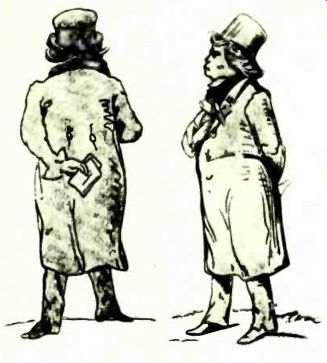
------------- Beethoven. Two drawings by Joseph Daniel Böhm, c. 1820.
André Meyer, Paris.
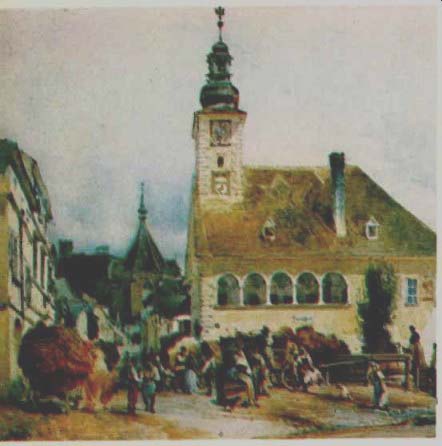
------------- Mödling: the Rathaus. Aquarelle by Rudolph von Alt.
Niederösterreichisches Landesmuseum, Vienna.
Soon, Beethoven became a familiar figure as he walked arouno and on Vienna's city walls and in the country suburbs. The talented young artist Böhm has given us the nearest thing to a contemporary photograph in these vivid little sketches.
Before his hearing began to deteriorate, Beethoven made concert trips as far away as Dresden, Leipzig, and Berlin. He also had great successes as a pianist/ composer in what is now Budapest, in Prague, and in the charming city of Pressburg on the Danube, about a day's carriage drive from Vienna down the great river.
Beethoven also grew very fond of the Bohemian spas and was a frequent visitor at Teplitz, Karlsbad, and Franzenbad. At Teplitz in 1812 he met the sophisticated Goethe, who found Beethoven too loud and somewhat vulgar. He spent several summers in Mödling, a delightful medieval town at the edge of the mountains south of Vienna, and particularly loved to walk in the surrounding countryside, carrying his little sketchbooks and working out his compositions. At Karlsbad in 1815 he went to visit his still unidentified "Immortal Beloved."
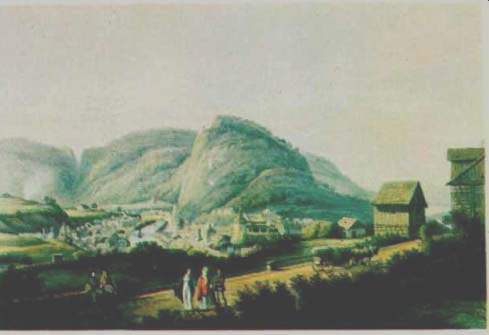
------- Karlsbad. Colored engraving by F. W. Rothe from a design
by J. G. Jentzsch. Freies Deutsches Hochstift. Frankfurt Goethe museum.
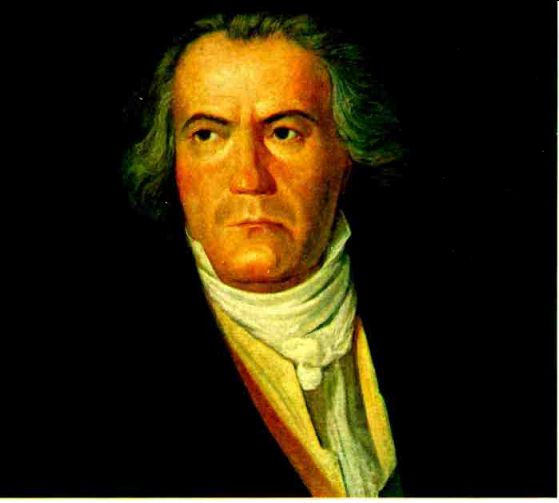
------- Beethoven. Portrait in oils by Ferdinand Georg Waldmüller.
1823.
From a photograph of the original, which belonged to Breitkopf & Härtel in Leipzig and was destroyed during World War 11.
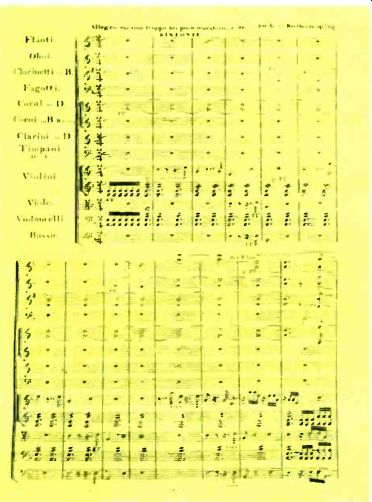
-------- Symphony No. 9 in D minor. Op. 125. First edition, published
by Schott in Mainz. Hans Hammelmann, Vecoli.
The Ninth Symphony was performed for the first time in May 1824 at a benefit concert Beethoven gave in Vienna. It created an enormous impression and the audience broke into spontaneous applause during the kettledrum entries in the Scherzo. At the end, Beethoven, his back to the audience and by now totally deaf, was unaware of the tumultuous applause. The pretty soprano Karoline Unger gently turned the gray-headed master around so that he could see, if not hear, the acclaim.
(Later, Beethoven sold the publication rights to the great German publishers Schott, a firm that is now the leading music publisher in Europe.) Beethoven had become very irritable. As his hearing began to fail, he cut himself off more and more from society. He would not, for instance, grant Waldmüller-certainly the greatest artist who ever painted him-more than one sitting, so that what we have in the above painting is somewhat of a compromise. At any rate, it shows something of the defiant genius in a world of his own.
Death came to the composer on March 26, 1827. Beethoven was never a healthy man and suffered from intestinal disorders throughout his life. In the late autumn of 1826 he caught pneumonia riding back from the country to Vienna in an open carriage. His doctors managed, miraculously, to cure the pneumonia, but dropsy ensued, and after a hideously long illness, which he bore with great courage, Beethoven finally succumbed. Several contemporaries describe a curiously unsettling and violent thunderstorm which broke over Vienna as Beethoven was dying. The thunderclaps were reported to sound as loud as cannon shots, and Beethoven raised himself up from his deathbed and shook his fist at the heavens before he lay back to die. Some 20,000 people attended his funeral and the great Austrian poet Grillparzer wrote the funeral oration. One of the pallbearers was Franz Schubert, himself to follow Beethoven to the grave the next year.
In 1812 Beethoven's friend, the piano maker Johann Andreas Streicher, commissioned the sculptor Franz Klein to make a bust of the forty-two-year-old composer. Klein at first made a plaster mask of Beethoven's face, which was accomplished with considerable difficulty because Beethoven imagined he would suffocate: the composer seems to have ruined the first attempt. The second was, however, eminently successful. The Beethoven-haus in Bonn owns two copies of this mask. There are three other copies in Vienna. The death mask was made by Danhauser a day after Beethoven's death. Again, the Beethoven-haus owns a copy. The Vienna mask, far preferable, once belonged to Franz Liszt.
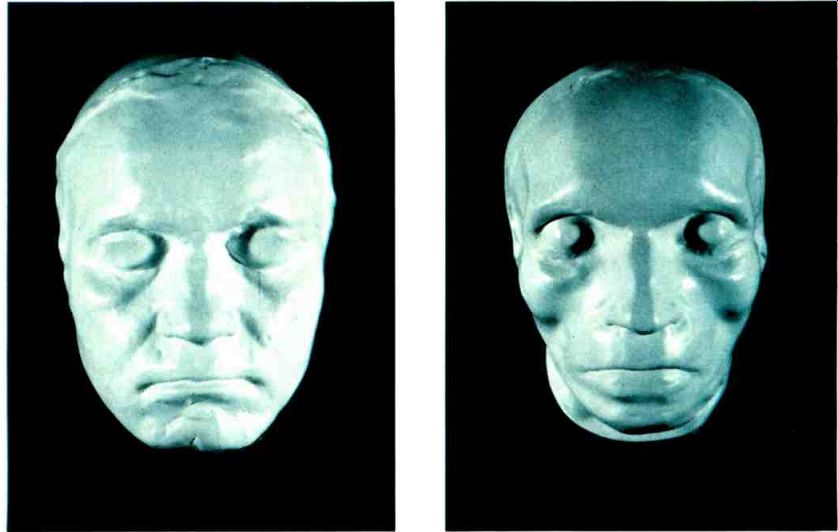
---------- Ludwig van Beethoven. Plaster cast ("life mask ")
by Franz Klein. Beethovenhaus, Bonn.
--------- Ludwig van Beethoven's death mask, by Joseph Danhauser.
Historisches Museum of the City of Vienna.
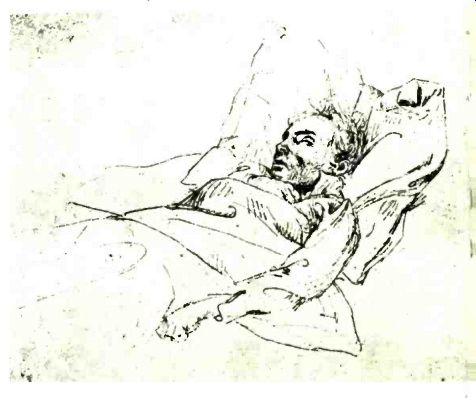
----------- Beethoven on his Deathbed. Pencil sketch by Joseph
Eduard Teltscher. Mrs. Eva Alberman, London.
-------------
( High Fidelity magazine)
Also see: